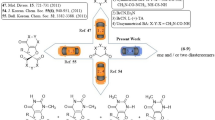Alkylation of N-methylmorpholinium 4-Ar1-3-cyano-6-oxo-1,4,5,6-tetrahydropyridine-2-thiolates using ethyl 4-Ar-6-bromomethyl-2-oxo-1,2,3,4-tetrahydropyrimidine-5-carboxylates (10 % KOH, DMF) gives mixtures of diastereomers of ethyl 4-Ar-6-[(4-Ar1-3-cyano-1,4,5,6-tetrahydropyridin-2-ylthio)methyl]-1-methyl-2-oxo-1,2,3,4-tetrahydropyrimidine-5-carboxylates in overall 30-58 % yield. Under these conditions the N-methylmorpholinium 4-Ar1-5-(N-Ar2-carbamoyl)-3-cyano-6-methyl-1,4-dihydropyridine-2-thiolates undergo aromatization of the dihydropyridine ring to give ethyl 4-Ar-6-[4-Ar1-5-(N-Ar2-carbamoyl)-3-cyano-6-methylpyridin-2-ylthio)methyl]-2-oxo-1,2,3,4-tetrahydropyrimidine-5-carboxylates (37-51 %). In the absence of KOH, only the substituted pyridine-2(1 H)-thione is formed as a product of oxidation of the dihydropyridine ring in the starting substrate. Some of the alkylation products obtained possess weak or moderate antibacterial activity towards the specific strains of Escherichia coli and Bacillus subtilis but are inactive towards Candida albicans and Staphylococcus aureus.




Similar content being viewed by others
Notes
* Integrated intensity of the signal lowered due to partial deuterium exchange.
References
V. P. Litvinov, V. K. Promonenkov, Yu. A. Sharanin, and A. M. Shestopalov, in: Science and Technology Results. Organic Chemistry. Current Trends in the Discovery and Use of Chemical Agents for Plant Protection. The Chemistry of Azines, Vol. 17, VINITI, Moscow (1989), Part II, p. 73.
V. P. Litvinov, S. G. Krivokolysko and V. D. Dyachenko, Khim. Geterotsikl. Soedin., 579 (1999). [Chem. Heterocycl. Compd., 35, 509 (1999)].
V. P. Litvinov, Izv. Akad. Nauk, Ser. Khim., 2123 (1998).
V. P. Litvinov, Phosphorus, Sulfur Silicon Relat. Elem., 74, 139 (1993).
V. P. Litvinov, L. A. Rodinovskaya, Yu. A. Sharanin, A. M. Shestopalov, and A. Senning, Sulfur Reports, 13, 1 (1992).
V. P. Litvinov, V. V. Dotsenko, and S. G. Krivokolysko, Izv. Akad Nauk, Ser. Khim., 847 (2005).
V. P. Litvinov, V. V. Dotsenko, and S. G. Krivokolysko, The Chemistry of Thienopyridines and Related Systems [in Russian], Nauka Russian Academy of Sciences, Moscow (2006).
V. P. Litvinov, V. V. Dotsenko, and S. G. Krivokolysko, Adv. Heterocycl. Chem., 93, 117 (2007).
E. A.-G. Bakhite, Phosphorus, Sulfur Silicon Relat. Elem., 178, 929 (2003).
G. Zigeuner, H. Hamberger, H. Blaschke, and H. Sterk, Monatsh. Chem., 97, 1408 (1966).
V. V. Dotsenko, S. G. Krivokolysko, V. P. Litvinov, and A. N. Chernega, Izv. Akad. Nauk, Ser. Khim., 339 (2002).
V. V. Dotsenko, S. G. Krivokolysko, V. P. Litvinov, and A. N. Chernega, Izv. Akad. Nauk, Ser. Khim., 918 (2003).
V. V. Dotsenko, S. G. Krivokolysko, and V. P. Litvinov, Mendeleev Commun., 13, 267 (2003).
V. V. Dotsenko, S. G. Krivokolysko, and V. P. Litvinov, Mendeleev Commun., 14, 30 (2004).
V. V. Dotsenko, S. G. Krivokolysko, and V. P. Litvinov, Reports of Moscow State University, Series 2, Chemistry [in Russian], 46, 304 (2005).
V. V. Dotsenko, S. G. Krivokolysko, and V. P. Litvinov, Khim. Geterotsikl. Soedin., 311 (2009). [Chem. Heterocycl. Compd., 45, 253 (2009)].
V. V. Dotsenko, S. G. Krivokolysko, V. P. Litvinov, and A. N. Chernega, Khim. Geterotsikl. Soedin., 716 (2007). [Chem. Heterocycl. Compd., 43, 599 (2007)].
A. W. Bauer, W. M. M. Kirby, J. C. Sherris, and M. Turck, Am. J. Clin. Pathol., 45, 493 (1966).
V. D. Dyachenko, S. G. Krivokolysko, V. N. Nesterov, and V. P. Litvinov, Khim. Geterotsikl. Soedin., 1243 (1996). [Chem. Heterocycl. Compd., 32, 1066 (1996)].
S. G. Krivokolysko, V. D. Dyachenko, and V. P. Litvinov, Zh. Org. Khim., 33, 1088 (1997).
V. D. Dyachenko and A. N. Chernega, Khim. Geterotsikl. Soedin., 51 (2006). [Chem. Heterocycl. Compd., 42, 45 (2006)].
Author information
Authors and Affiliations
Corresponding author
Additional information
Translated from Khimiya Geterotsiklicheskikh Soedinenii, No. 3, pp. 492-499, March, 2012.
Rights and permissions
About this article
Cite this article
Dotsenko, V.V., Lebedeva, I.A., Krivokolysko, S.G. et al. Reaction of ethyl 4-aryl-6-bromomethyl-2-oxo-1,2,3,4-tetrahydropyrimidine-5-carboxylates with N-methylmorpholinium 3-cyano-1,4-dihydro- and 3-cyano-1,4,5,6-tetrahydropyridine-2-thiolates. Chem Heterocycl Comp 48, 462–469 (2012). https://doi.org/10.1007/s10593-012-1016-0
Received:
Revised:
Published:
Issue Date:
DOI: https://doi.org/10.1007/s10593-012-1016-0




